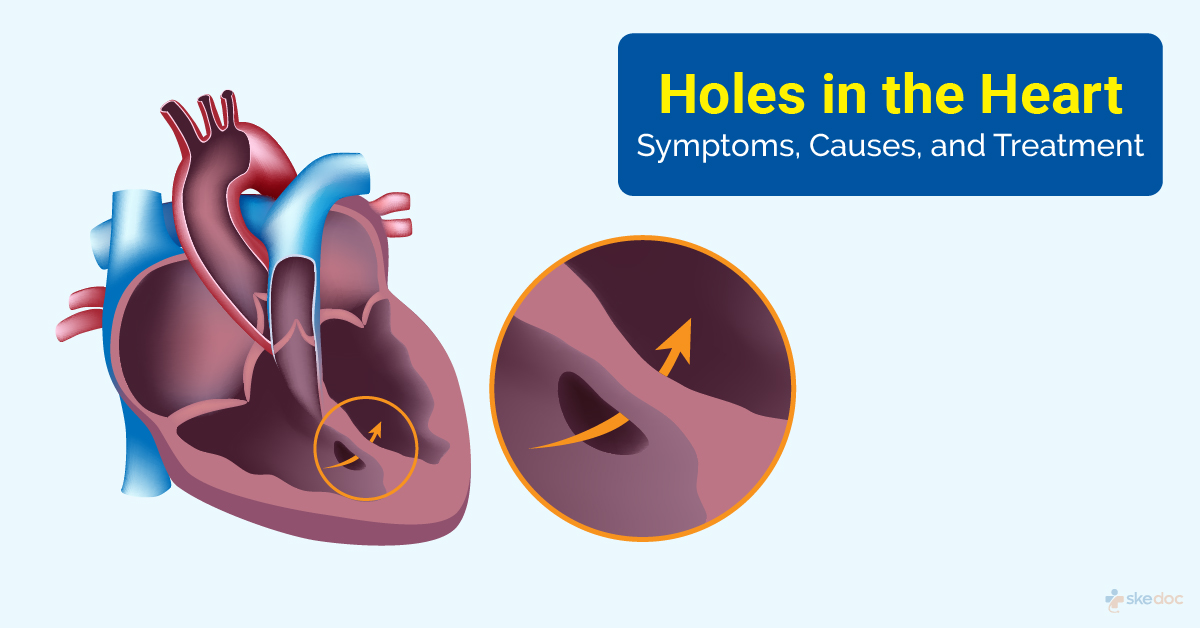Allergy
Blood Diseases
Bone & Joints
Brain
Cancer
Child Care
Cosmetic Surgery
Diabetes
Endocrinology
ENT
Eye
Gen Medicine
General Surgery
Heart
Kidney
Lifestyle
Liver & Digestive
Lung
Men’s Health
Mental health
Physiotherapy
Rheumatology
Skin and hair
Sleep Disorders
Spine
Transplant
Women Health
Thyroid
Vascular Surgery
Holes in the heart

What are the holes in the heart?
Holes in the heart are defects in the heart's structure that are present at birth and interfere with the normal flow of blood within the heart's chambers. The heart has two sides, namely the left and the right side, and four chambers, namely the upper right (right atrium), the lower right (right ventricle), the upper left (left atrium), and the lower left (left ventricle), which are separated by a wall.
The right side of the heart receives the deoxygenated blood from the body sent to the lungs, and the left side receives the oxygenated blood from the lungs and then sent to the body. When abnormal openings are present in the walls that separate these chambers, it disrupts the normal blood flow and mixes the deoxygenated and the oxygenated blood.
Alternate name
- Congenital heart defects
Are holes in the heart a medical emergency?
Holes in the heart are not a medical emergency, although untreated, some of them can lead to complications and become fatal.
Types
Holes in the heart are of the following types:
- Atrial septal defect (ASD) - The hole in the heart in the septum separates the two upper chambers (left and right atrium).
- Atrial septal defect secundum - The defect is in the middle of the atrial septum, which is the most common, and a majority of them are close on their own.
- Atrial septal defect primum - The defect is in the lower part of the atrial septum, not very common, and do not close on their own.
- Sinus venosus atrial septal defect - The defects are in the upper part of the atrial septum and near the entry of the superior vena cava, rare and do not close on their own.
- Ventricular Septal Defect (VSD) - The hole in the heart is present in the septum that separates the lower two chambers (left and right ventricle). Ventricular septal defects may be small or large, single or multiple.
- Membranous VSD - They are located near the valves in the membranous portion of the interventricular septum.
- Muscular VSDs - These are located in the lower muscular portion of the inter-ventricular septum.
- Inlet VSDs - Found close to the inlet valves of the chamber, not very common.
- Outlet VSDs - Found close to the outlet valves of the chamber, not very common.
Causes
The exact reasons for the formation of holes in the heart are not fully understood.
However, some of the following may play a role:
- Genetic and hereditary factors
- Environmental factors -
- Infections - rubella
- Drugs - lithium, alcohol, hydantoin, thalidomide
Risk factors
Some risk factors for the development of holes in the heart include:
- Maternal diabetes, SLE, phenylketonuria
- Maternal obesity
- Maternal and paternal alcoholism
Signs & symptoms
Some of the symptoms and signs of holes in the heart in adults include:
- Fatigue
- Tiring easily during physical activity
- Shortness of breath
- A build-up of blood and fluid in the lungs
- A build-up of fluid in the feet, ankles, and legs
Some of the symptoms and signs of holes in the heart in infants include:
- Poor feeding
- Poor growth
- Irritability and fatigue
- Reduced interest in toys or physical activity
Investigations
Some of the investigations that may be done to establish a diagnosis of holes in the heart include:
- Laboratory tests
- CBP & ESR
- Complete metabolic panel
- Coagulation profile and blood typing
- Arterial blood gas measurement
- Imaging tests
- Chest x-ray
- Transthoracic echocardiography
- Doppler echocardiography
- MRI
- Angiography
- Electrocardiography
- Cardiac catheterization
- Pulmonary function tests
Diagnosis
A diagnosis of holes in the heart is established based on medical history, clinical evaluation, and results of the investigations done.
Treatment options
Most holes in the heart close without intervention and may not require treatment other than careful observation. The treatment of holes in the heart depends on the type and degree of the condition and may include medical and/or surgical intervention.
Medical management
Medical management may include:
- Diuretics - For the management of hypertension and heart failure seen in VSD.
- ACE Inhibitors - Used for the management of congestive heart failure.
- Inotropic agents - Used in the management of chronic heart failure and arrhythmias.
Interventional including surgery and indications for surgery
Interventional management of holes in the heart may require surgery, and hole in the heart surgery is indicated especially in VSD if they are:
- Large in size
- Causing symptoms
- Causing dilation of the heart
- Leading to heart failure
Intervention may be in the form of,
- Open heart Surgery - Done in primum and sinus venous ASD and membranous VSDs
- Minimally invasive/transcatheter procedures - Secundum ASDs and muscular VSDs
Role of Diet/Exercise/Lifestyle changes/Preventive measures
Some measures that may be needed for the management of holes in the heart:
- Periodic monitoring and cardiology consultations
- High-calorie diet in infants with VSDs
- Antibiotic prophylaxis before undergoing surgical or dental procedures
- Good hand and oral hygiene to reduce the risk of infections
Complications
- Congestive heart failure
- Heart arrhythmias
- Pulmonary hypertension
- Stroke
- Infective endocarditis
- Pericardial effusion
- Sudden death
Prognosis
The prognosis for holes in the heart is generally very good, with most of the closing without any intervention. Early diagnosis and management help in the prevention of complications, morbidity, and death.
When to contact the doctor or hospital/how to identify the emergency or complications?
It is advisable to seek medical attention if the signs and symptoms are noticed.
Indications for hospitalization if required
Hospitalization may be required for the management of holes in the heart when surgical interventions are recommended.
Screening methods
Prenatal screening may be advisable if there is any family history.
Suggested clinical specialists/departments to consult for this condition
Holes in the heart are attended to by specialists from the pediatric cardiology department, adult congenital heart disease.
Was this article helpful?
YesNo




